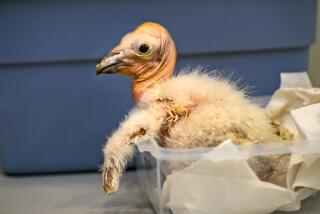U.S. to Buy 11,000-Acre Ranch in Kern County as Refuge for Condors
The U.S. Fish and Wildlife Service announced an agreement Tuesday to purchase the 11,000-acre Hudson Ranch in the foothills of southern Kern County as a refuge for the highly endangered California condor.
The ranch is expected to become federal property by year’s end, Joe Dowhan, the wildlife service’s condor coordinator, said Tuesday. Several smaller contiguous parcels of cattle grazing land in the southern San Joaquin Valley have already been purchased.
The price was not made public Tuesday because it is higher than the land’s appraised value and therefore requires concurrence by appropriations subcommittees in the House and Senate before the deal is final, Dowhan said. The concurrences will pose no problem, Dowhan said, adding that the purchase price is less than half the $9 million appropriated by Congress in 1984 to buy Hudson Ranch.
Biologists have for years identified the isolated expanse of grasslands and steep canyons as one of the most important foraging areas for the bird and say that no other area in the condor’s range--from coastal Ventura County to eastern Tulare County--has seen greater condor use. It is also the major area for trapping condors for captive breeding programs at the Los Angeles and San Diego zoos.
The Hudson families have grazed cattle in the area for more than 100 years and have documented condor use for much of that time. In 1950, 50 birds were observed on the ranch at one time. As late as 1982, 14 birds were seen there, the largest concentration in the last quarter of a century.
After the Fish and Wildlife Service takes control of the ranch, it will become the Bitter Creek National Wildlife Refuge and a mangement plan will be drawn up to protect the habitat not only for the condor but for several other endangered plants and animals, including the San Joaquin kit fox. The ranch is bordered on three sides by land owned by the U.S. Forest Service and the U.S. Bureau of Land Management, providing buffers from development and other intrusions, officials said.
Three condors--all males--remain in the wild and are to be trapped because officials can no longer guarantee their safety in nature until additional protected habitats are established to prevent lead poisoning of the birds from contaminated deer carcasses left by hunters. The three birds are to be added to 24 already at the two zoos to increase the gene pool for breeding. The first captive breeding is hoped for next year and first releases are expected between 1990 and 1992.
Peter Berle, president of the National Audubon Society, praised the new refuge Tuesday as an important potential release site and a symbol of the federal commitment to saving the unusual bird, whose 9 1/2-foot wing span allows it to fly up to 100 miles a day and soar eight to 10 miles at a stretch on a thermal air current without so much as flapping its wings.
Audubon first proposed purchase of the ranch in 1982, Berle said, and lobbied particularly hard for the refuge during the last year in hopes that the area would remain available for the condor during the time when no birds remain in the wild.
“The real objective should not be lost, which is to establish wild flocks again,” Berle said.
Both Berle and Dowhan said they hope that continued cattle grazing, on a permit basis, will be allowed under the management plan. Dowhan said that cattle grazing keeps shrubs and other plants from overwhelming the open country on which the condors depend for food. In addition, stillborn calves and other cattle carcasses are an important source of food for the condors, golden eagles and other birds in the area, he said.
More to Read
Sign up for Essential California
The most important California stories and recommendations in your inbox every morning.
You may occasionally receive promotional content from the Los Angeles Times.










